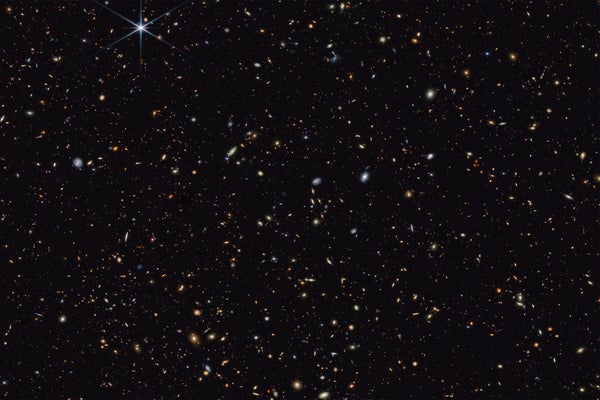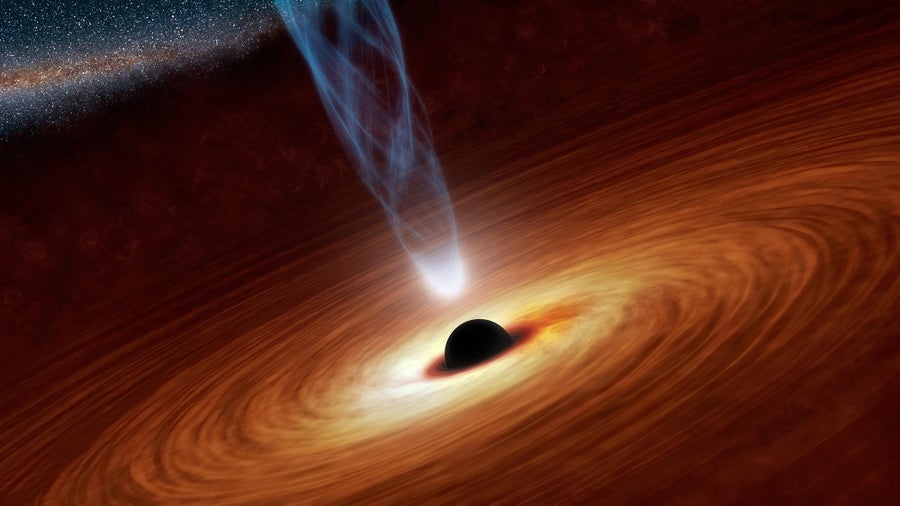JWST’s ‘Little Red Dots’ Offer Astronomers the Universe’s Weirdest Puzzle
The James Webb Space Telescope’s search for the earliest stars and black holes has yielded a very weird, very red, puzzle

Faraway galaxies dot the void like scattered jewels or grains of sand in this deep field image from the James Webb Space Telescope. The most distant galaxies in such images tend to appear as small, reddish blobs.
NASA, ESA, CSA, STScI, Brant Robertson (UC Santa Cruz), Ben Johnson (CfA), Sandro Tacchella (Cambridge), Marcia Rieke (University of Arizona), Daniel Eisenstein (CfA)
Technological advancements often reveal puzzles hiding beneath the surface of reality. Infrared cameras, for example, helped discover a hidden portrait a decade ago within The Blue Room, one of Picasso’s early masterpieces. The cameras pierced the artist’s overlying brushstrokes to reveal a sketch of an elegant and mysterious man wearing a bow tie and three rings and holding his chin. As usual, this discovery raised more questions than it answered: Who was this gentleman, and why had Picasso buried his image under thick paints?
The infrared eyes of NASA’s James Webb Space Telescope (JWST), the most advanced off-world observatory yet built, have also unveiled something cryptic—and far more profound than a bearded man. This time, the mystery lies beneath the surface of the faintest objects in the ancient universe. JWST’s farsighted scrutiny has unveiled the existence of an enigmatic population of galaxies in the early universe previously unknown to astronomers. Like Picasso’s mysterious man, these galaxies—small ruddy blobs aptly nicknamed “little red dots” (LRDs)—appear odd and out of place.
JWST is a powerful telescope specifically designed to study the “cosmic dawn,” the early-universe epoch when the first stars and black holes were born. The light from this time that reaches us today is extremely faint, dimmed after a long journey across billions of light-years. And, although it began as ultraviolet and visible light, the shine from these objects has been redshifted to the infrared—a phenomenon caused by the expansion of space stretching light’s wavelengths as it crosses the cosmos. Gathering this light, JWST has revealed fainter and farther galaxies than ever before. And somewhat surprisingly, many of these galaxies are redder and more compact than anyone expected.
On supporting science journalism
If you’re enjoying this article, consider supporting our award-winning journalism by subscribing. By purchasing a subscription you are helping to ensure the future of impactful stories about the discoveries and ideas shaping our world today.
These little red dots have stirred the imaginations of astronomers worldwide, as they may have major implications for our understanding of cosmic evolution. But to date, their exact nature and what exactly they’re telling us about the early universe remains uncertain.
Some things, however, are clear. Most of the LRDs blazed during a relatively short period lasting one billion years, and starting about 600 million years after the big bang. In a tantalizing mystery, outside of their ancient relic light picked up by JWST, there seems to be no trace of them in today’s universe. Why did they vanish? Or what did they morph into? Their sudden disappearance is a profound enigma.
Their distinctive redness isn’t merely a matter of redshifting; rather it indicates they were emitting large amounts of light at longer, redder wavelengths. Whether this is from an intrinsically red galaxy, or instead from large amounts of dust that can redden light, is unknown. Their compactness is also disconcerting: a typical LRD has an approximate radius of no more than 500 light-years, while for some of them it can be smaller than 150 light-years. Our own Milky Way galaxy, in the modern-day “local” universe, is more than 100 times bigger!
This is about all we know. The road before us now forks off in at least two branches; little red dots are either galaxies hosting a central supermassive black hole; or they are galaxies hosting a vast number of stars in a small volume. Each interpretation has problems.
First, clues strongly suggest that, similar to all large galaxies we see in our local universe, these LRDs from the early universe harbor a central supermassive black hole, one between a few million and a few hundred million times the mass of our sun. We can ascertain them by their spectra, the rainbowlike chart of individual wavelengths, or colors, of light they emit. Black holes themselves don’t emit light, but matter falling into them releases copious amounts of radiation, powerfully shining to help detail its demise. Astronomical spectra can indicate how fast gas is racing around a black hole, fighting its immense gravitational field, and effectively allowing the black hole to be weighed. This signature—the broadening of some features in the spectra—is present in most of the LRDs, indicating gas velocities of thousands of kilometers per second, just as would be expected for material spiraling to its doom near a supermassive black hole.

An artist’s concept of a supermassive black hole with millions to billions times the mass of our sun, feeding on a swirling accretion disk of gas and dust and producing a powerful jet of radiation and particles.
However, the black hole hypothesis is also marked by something bizarre. A significant fraction of the light produced by material falling into a black hole comes in the form of x-rays. The little red dots should thus be visible to x-ray telescopes if they contain supermassive black holes. In one of the most puzzling plot twists of modern astronomy, they are not: most of the LRDs discovered so far show no sign of x-ray emission.
And the oddities keep coming. In the nearby universe, profound correlations—or scaling relations—exist between the mass of a central black hole and the number of stars in its host galaxy. Typically, such a black hole’s bulk is about 0.1 percent of the total mass of its galaxy’s stars—a clue that these two profoundly different astronomical objects somehow co-evolved. If the LRDs contain supermassive black holes, these would seem much more massive than what that well-known scaling relation would dictate, weighing in at up to a mind-boggling 40 percent of the stellar mass of their entire galaxy. This peculiarity could be crucial evidence for establishing how the first black holes formed at even earlier cosmic epochs scarcely plumbed even by JWST.
What if the little red dots contain only stars? Black holes feasting on matter are generally much more efficient than stars at producing light. Hence for stars alone to make the amount of light observed from these galaxies, vast numbers are required. Imagine squeezing a Milky Way’s worth of stars into a volume with a radius 100 times smaller than our familiar home spiral galaxy. If we placed a sphere centered on our sun and with a radius of 4.24 light years, it would contain only another star: Proxima Centauri. The same sphere placed in one of these LRDs would contain, on average, more than one million stars. The song “A Sky Full of Stars” would acquire an entirely new meaning there.
What, then, are these mysterious apparitions so near the break of cosmic dawn? The truth is, we do not know—yet. Future investigations with JWST, especially at longer wavelengths in the infrared, to probe the emission of dusty structures around central supermassive black holes, may help. Furthermore, deeper x-ray observations—also with next-generation, high-resolution x-ray observatories, such as the proposed AXIS—will hopefully detect high-energy photons from the LRDs.
Much like Picasso’s mysterious gentleman with a bow tie, these enigmatic objects seem to inhabit an alternate reality, one that tells a story from an unexplored chapter of cosmic history. With time, astronomers will reconcile them with our current understanding of the machinery of the universe. For the moment, however, we keep wondering, awestruck and searching for answers.
This is an opinion and analysis article, and the views expressed by the author or authors are not necessarily those of Scientific American.
